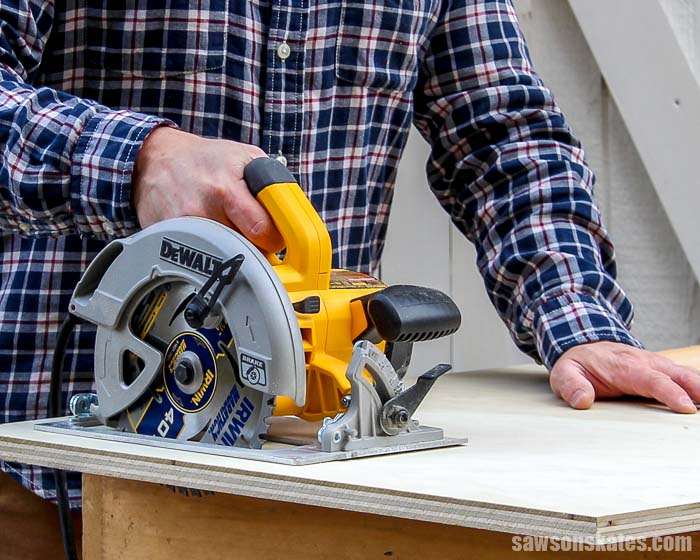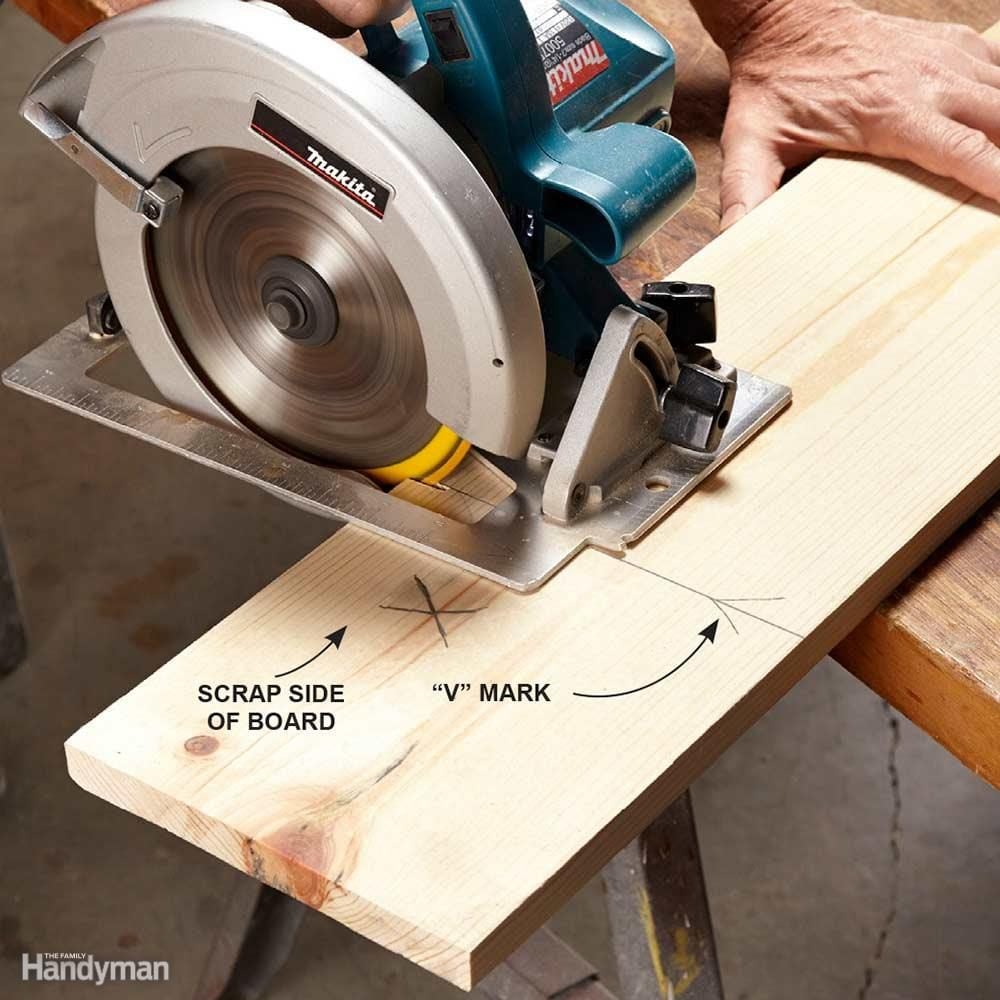Are you excited to learn about using a circular saw? Well, get ready to dive into the world of woodworking! When using a circular saw, there are some important things to keep in mind to ensure a smooth and successful cutting experience. In this guide, we’ll explore the essential tips and precautions that will help you make accurate and clean cuts with your circular saw.
Cutting with a circular saw can be thrilling, but safety should always come first. To avoid accidents, it’s crucial to understand the proper techniques and precautions. We’ll discuss the importance of wearing safety goggles, using a stable work surface, and maintaining a firm grip on the saw while cutting.
With the right knowledge and technique, a circular saw can be a powerful tool in your woodworking arsenal. So let’s get started and learn how to make precise cuts with confidence and finesse using your circular saw! But before we unleash the cutting frenzy, let’s talk about safety and some essential precautions to keep you protected.
1. Choose the right blade for the material you’re cutting.
2. Secure the workpiece tightly to prevent movement.
3. Wear appropriate safety gear, including goggles and gloves.
4. Measure and mark your cut line before starting.
5. Position the saw properly with both hands on the handles.
By following these steps, you can use a circular saw safely and achieve precise cuts. Stay safe and happy cutting!

Mastering the Circular Saw: Essential Tips for Cutting Success
When it comes to using a circular saw, precision and safety are paramount. Whether you’re a professional carpenter or a DIY enthusiast, understanding the proper techniques for cutting with a circular saw is crucial. In this guide, we’ll walk you through everything you need to know to make clean and accurate cuts with confidence. From choosing the right blade to maintaining the saw’s performance, we’ll cover it all. So, let’s dive in and unlock the secrets of cutting with a circular saw!
Choosing the Right Blade for the Job: Cutting Through the Options
When it comes to circular saw blades, a one-size-fits-all approach doesn’t apply. To achieve the best results, you’ll need to select a blade that suits your specific cutting task. Let’s explore the different types of circular saw blades and when to use them.
The Rip-Cutting Blade: Powering Through Long Cuts
The rip-cutting blade is designed to cut efficiently along the length of the workpiece, parallel to the wood grain. This type of blade typically has fewer teeth with larger gullets, ensuring it can quickly remove wood chips as it moves through the material. It’s ideal for cutting down large panels, plywood, and other long workpieces. However, due to its aggressive nature, it may leave a rough finish. When using a rip-cutting blade, be sure to use a guide or a straight edge to maintain a straight cut.
It’s important to note that using this type of blade for cross-cutting or fine woodworking may result in splintering or tear-out along the cut. If you have a mixed cutting task or require a smoother finish, you may want to consider alternative blade options.
The Cross-Cutting Blade: Finely Tuned Precision
The cross-cutting blade is designed for making accurate cuts across the wood grain. It usually features more teeth and a smaller gullet, enabling it to slice through the wood fibers with less tear-out. This type of blade is perfect for trimming boards, creating precise angles, and achieving clean edges. When using a cross-cutting blade, take your time and ensure the blade is properly aligned with your cut line for the best results.
While the cross-cutting blade delivers excellent finish quality, it may require more effort and time to complete longer cuts compared to a rip-cutting blade. Therefore, it’s essential to choose the right blade based on the specific requirements of your project to achieve the desired results efficiently.
Ensuring Safety First: The Importance of Proper Technique and Protective Gear
When working with a circular saw, nothing is more important than safety. Before diving into any cutting task, it’s essential to understand the proper techniques and equip yourself with the necessary protective gear. Let’s explore some key safety tips to keep in mind:
Wear Protective Goggles and Ear Muffs
Always wear safety goggles to protect your eyes from flying debris and ear muffs to reduce noise exposure. Circular saws can generate high-speed rotations and produce loud noise, making these two pieces of protective gear essential.
Secure Your Workpiece
Before making any cuts, ensure your workpiece is well-secured. This prevents it from slipping or moving during the cutting process, reducing the risk of accidents. Use clamps or a vice to firmly hold down the workpiece and keep your hands at a safe distance from the rotating blade.
Use a Guide or Fence
To maintain straight and accurate cuts, consider using a guide or fence. This helps you achieve consistent results and prevents the saw from veering off course. You can make your own guide using a straight piece of wood or purchase a specialized guide system.
Start with a Shallow Cuts
When making a long or deep cut, it’s often best to start with a shallow cut first and gradually increase the depth. This allows for more control and reduces the chances of the saw getting stuck or causing kickback.
Avoid Overreach
During the cutting process, avoid overextending your reach or standing in an awkward position. Maintain a stable stance with your feet shoulder-width apart and ensure a comfortable grip on the saw’s handle. This helps maintain control and reduces the risk of accidents.
Key Takeaways: When Using a Circular Saw, Be Sure to Cut
- Always wear safety goggles to protect your eyes.
- Use a proper cutting technique by keeping a firm grip on the saw and guiding it smoothly.
- Ensure that the blade is sharp and in good condition to make clean and precise cuts.
- Measure and mark your cutting line accurately before starting the cut.
- Take your time and cut at a moderate speed to maintain control over the saw.
Frequently Asked Questions
Welcome to our frequently asked questions section about using a circular saw. Here, you’ll find answers to common inquiries related to operating a circular saw and ensuring proper cutting techniques.
1. How important is it to select the correct blade when using a circular saw?
Choosing the right blade is crucial when using a circular saw. Different blades are designed for specific materials, such as wood, metal, or masonry. By using the appropriate blade, you’ll achieve cleaner cuts, prevent blade damage, and increase the tool’s efficiency and lifespan. Make sure to read the blade’s specifications and select the one that matches the material you’ll be cutting.
Using the wrong blade can result in poor cutting performance, including splintering or burning of the material. It may also cause the blade to bind or kickback, posing a safety hazard. Take the time to select the correct blade for the job at hand.
2. How can I ensure a straight and accurate cut with a circular saw?
To achieve straight and accurate cuts with a circular saw, there are a few steps you can follow. First, use a straightedge guide or a rip fence to guide the saw along the desired cutting line. This helps maintain a consistent distance from the edge and ensures a straight cut.
Additionally, check that the blade is properly aligned and set to the correct depth. A misaligned blade can cause the saw to veer off course. Take your time and follow the manufacturer’s instructions to ensure the saw is adjusted correctly before making any cuts.
3. Do I need to wear personal protective equipment (PPE) when using a circular saw?
Absolutely! Safety should always be a priority when using power tools, including a circular saw. It is essential to wear the appropriate personal protective equipment (PPE). This includes safety glasses or goggles to protect your eyes from flying debris, ear protection to prevent hearing damage from the saw’s loud noise, and gloves to provide a secure grip and protect your hands.
Don’t forget to wear appropriate clothing, such as long sleeves and long pants, to protect your skin. Additionally, if you are working in a dusty environment, consider wearing a dust mask to prevent inhalation of particles.
4. What is the best way to handle kickback when using a circular saw?
Kickback can occur when the circular saw blade binds or gets pinched in the material being cut, causing the saw to jerk back toward the user. To prevent kickback, it’s essential to use the right cutting techniques. Maintain a firm grip on the saw’s handle with both hands, keeping your body positioned to the side or out of the saw’s potential path.
Ensure that the material being cut is properly supported and secured to prevent any movement or binding. It’s also recommended to use a riving knife or anti-kickback device, if available, as they help prevent kickback by keeping the material separated after the cut.
5. How should I maintain and store a circular saw?
Proper maintenance and storage are crucial for the longevity and performance of your circular saw. After each use, make sure to clean off any sawdust or debris from the tool, especially around the blade area. This prevents buildup that can affect the saw’s performance.
When storing your circular saw, keep it in a dry and secure location, away from children and pets. Consider using a protective case or cover to shield it from dust and damage. Regularly check the power cord for any signs of wear or damage, and if needed, have it repaired or replaced by a qualified professional.

Summary
Here’s what you need to know about using a circular saw safely:
Be sure to wear protective gear like goggles and gloves to keep yourself safe.
Measure and mark your cut accurately before starting to prevent mistakes.
Always use a guide or fence to keep your cut straight and reduce the chance of accidents.
Position the saw blade properly so it’s at the right depth for the material you’re cutting.
When making your cut, use a smooth and steady motion, letting the saw do the work.
And finally, never rush or force the saw through the material – take your time.
Remember, using a circular saw can be dangerous, but by following these tips you’ll be able to use it safely and effectively. Stay safe and happy cutting!
